From employees who are too qualified or underqualified for their roles to people working in industries that don’t align with their qualifications, we are experiencing a severe skills mismatch in today’s market.
With a generationally diverse workforce, varied levels of education, and candidates with differing backgrounds, people are inevitably filling roles that don’t align with their expertise, creating a skills gap businesses need to try and fill.
Many reasons lead to filling roles with the wrong people — whether it be neglecting to include crucial criteria in your job ad, misinterpreting someone’s qualifications, or an employee’s competency for a particular skill having faded over time.
And these skills mismatches are proving extremely costly to organizations, creating a greater need for them to assess candidates’ skills accurately.
So, how do you avoid a skill mismatch in your business?
This article will explore why a skills mismatch happens and offer tips to help you avoid creating skills gaps in your organization.
What is a skills mismatch?
A skill mismatch is a difference between the skills an employee should have to fulfill a role successfully, and the skills an employee or successful candidate actually has. A skills mismatch can result from a worker’s competencies failing to measure up to or exceeding those needed to complete the tasks associated with their role. And it can lead to workers feeling insecure about the security of their job, career development, and income, resulting in lower productivity, poor quality work, and a loss in revenue.
A skill mismatch in the workplace creates a skill gap that can have grave consequences for the performance of a business.
In the US:
- 92% of executives think that their employees aren’t skilled enough to do their jobs, according to a survey by Adecco.
- Less than a third of companies believe they have the talent necessary for digital transformation in their organizations.
- And, a LinkedIn study shows that 59% of hiring managers have problems finding and hiring employees with soft skills.
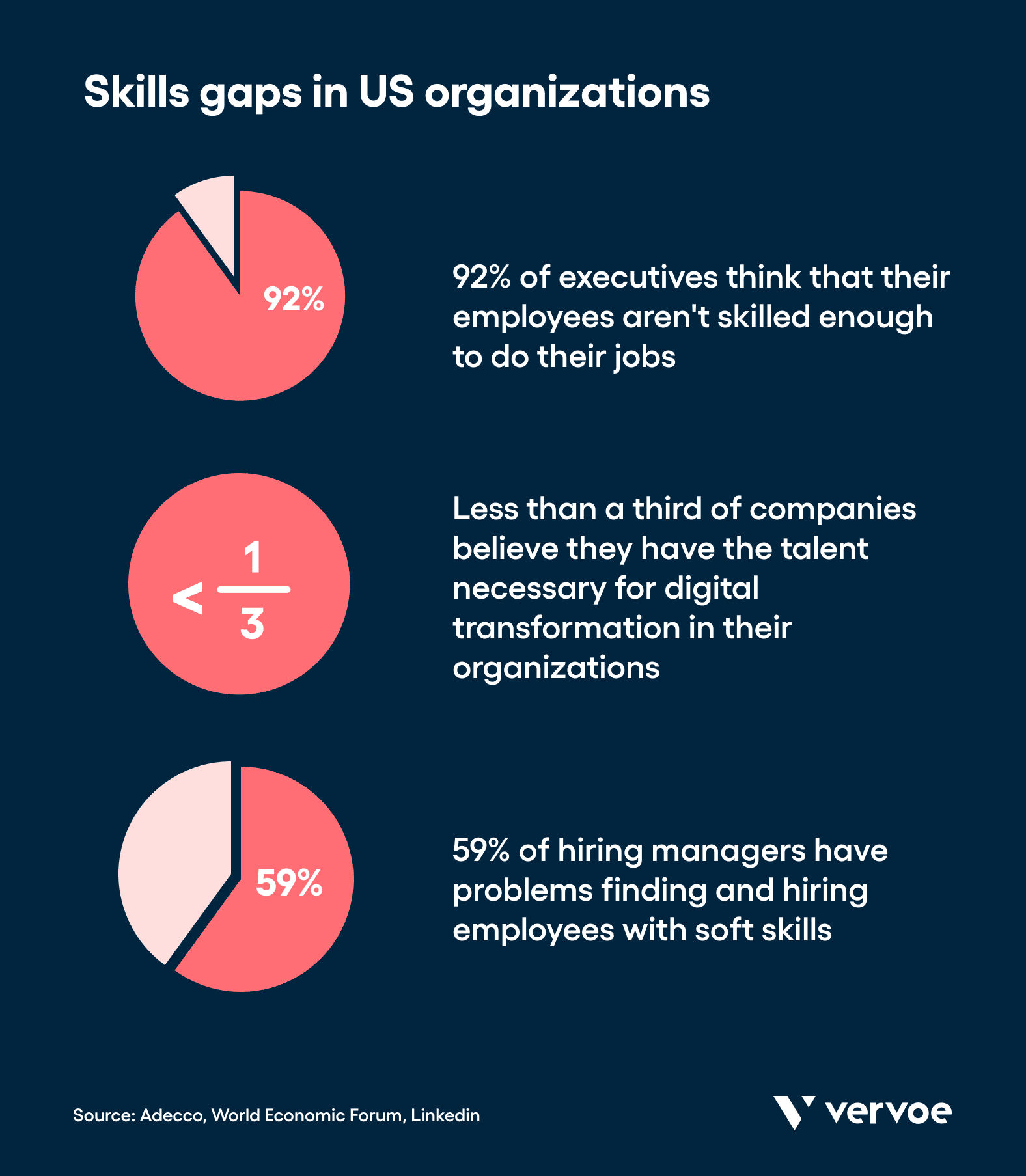
How does a skill mismatch happen?
Whether it’s underestimating the skills required to do a job, struggling to articulate the competencies you require in your hiring criteria, difficulty keeping up with a shrinking talent pool of skilled candidates, or not having implemented an effective way to assess skills, skill mismatches exist for a multitude of reasons. Here are some of the most common…
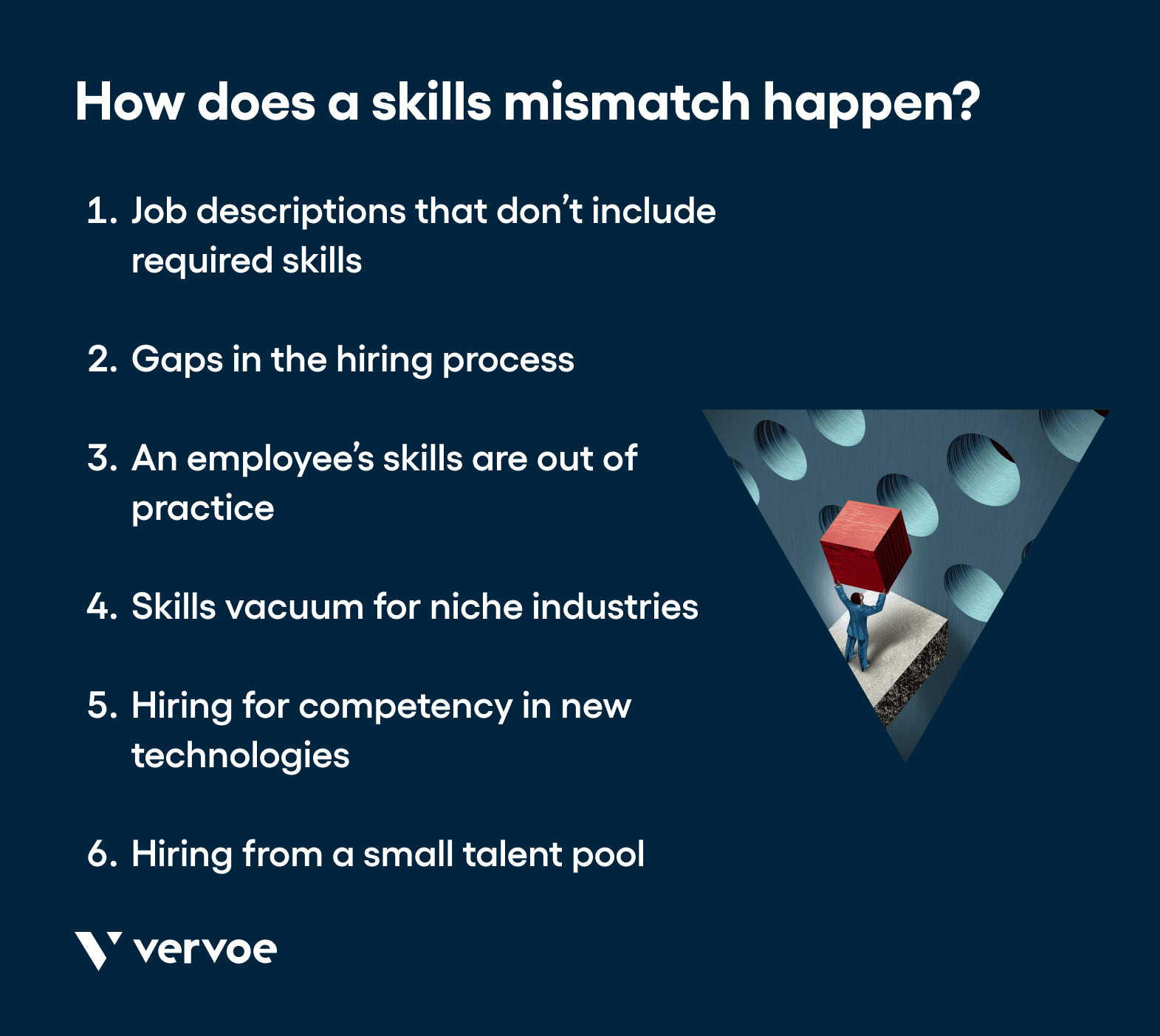
Job descriptions that don’t include required skills
When a job description isn’t aligned with the actual requirements of a job, it can lead to candidates who don’t have all the skills demanded applying for the role and successfully getting it. You’re then left with a worker who can’t fulfill all the key responsibilities to succeed, and you may soon have to rehire.
Gaps in the hiring process
Whether it’s miscommunication with the HR team, a lack of awareness of the full skill set required to satisfy the demands of a role, or a lack of tools to effectively test candidates’ skill level using situational questions, simulations, and more, gaps in your hiring process can lead to skills mismatches. A common step missing in many hiring processes is skills testing, which can offer a more accurate way to assess a candidate’s ability to complete tasks and identify skills matches than relying on tertiary education qualifications.
An employee’s skills are out of practice
Mismatches can happen when an employee technically has the skills required, but is either out of practice or is used to carrying them out on outdated technology. They may need to be retrained to adapt to current systems and ways of working. They may even require retraining via the education system or alternative educational offerings to adapt to new skills necessary to complete their tasks in the modern workplace.
Skills vacuum for niche industries
A skills vacuum may be created by highly skilled workers retiring, leaving a knowledge gap between them and the next generation of workers. This can often be a problem in specialized niche industries, where accumulated knowledge is an invaluable asset in the labour market.
Hiring for competency in new technologies
You may be filling a job that requires an employee to learn how to operate an entirely new technology from scratch and find it hard to identify the skill set of a person in the labour market who can successfully learn how to do this. This demand for open access to suitable candidates who can learn new technologies and think disruptively may be hard to tackle for employers.
Hiring from a small talent pool
A mismatch might be inevitable when the labour market talent pool for specific skills and abilities is perpetually small. This can be the case for specialized industries that service a small niche but are invaluable to that market. Encouraging candidates to undertake the qualifications or some kind of skills training program to develop the ability to complete those jobs and fulfill that demand is a holistic issue for employers, involving training, education, and open access.
What are the different skills mismatch types?
A skills mismatch is an overarching term that encompasses three main types of imbalances experienced in the workforce: horizontal mismatches, vertical mismatches, and skills obsolescence. Here is a breakdown of exactly what they mean…
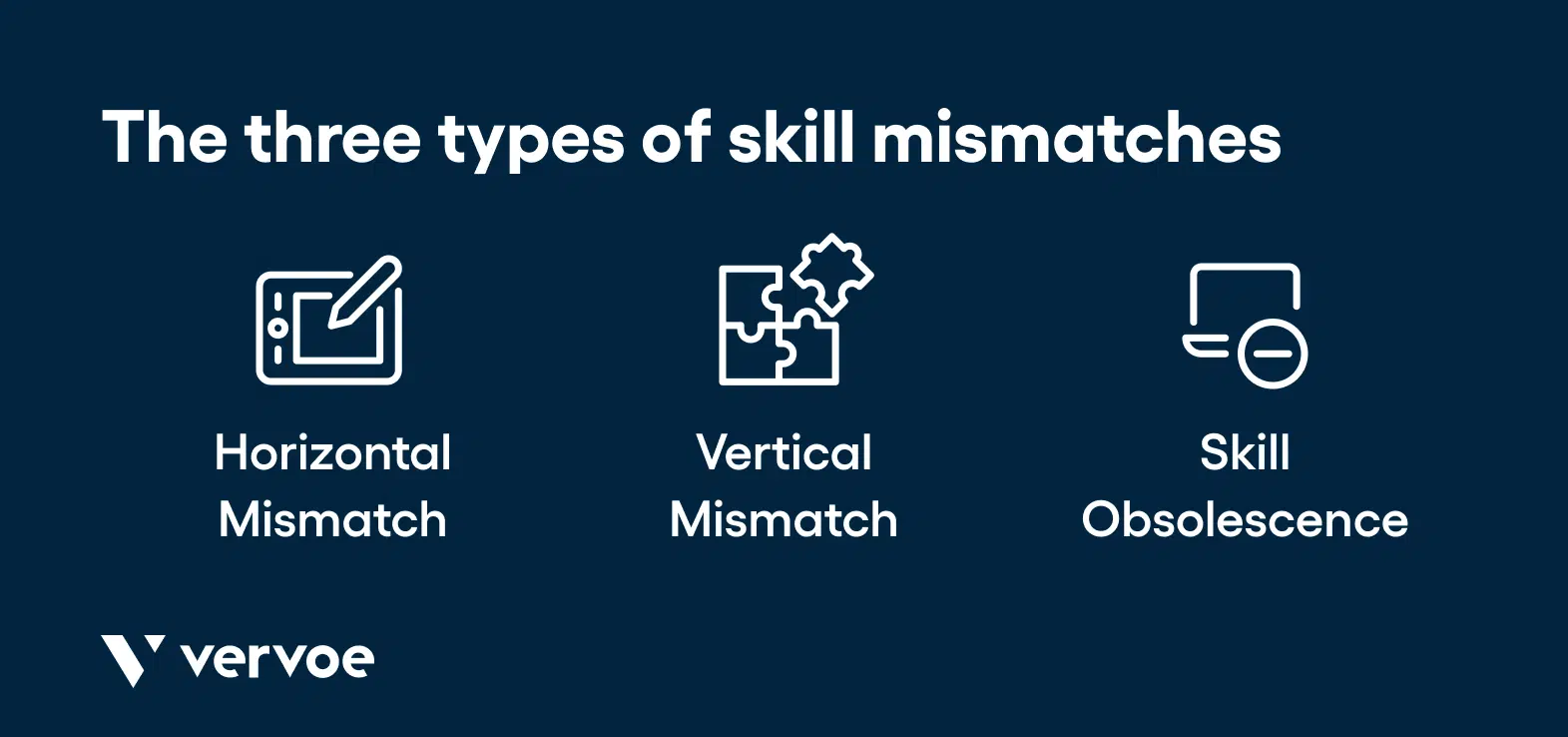
Horizontal Mismatch
Also referred to as a field of study mismatch, horizontal mismatches occur when a person works in a field different from what they studied or trained in. This might be a job they’ve fallen into after working in another industry, or they may have worked their way up in the organizations, getting on-the-job experience and training that’s led them to full-time work in this role.
Examples:
- A teacher who now works in HR
- A journalist who is now working in marketing
- An actor who is now a sales representative
Vertical Mismatch
A vertical mismatch occurs when an employee’s skill set isn’t on par with the level required by the job. This includes underqualified and overqualified people.
While the overqualified employee may experience disengagement and discontent, the underqualified employee is likely to feel disheartened by their inability to perform the main skills required by the role. Both types of vertical mismatches often result in dissatisfaction and a high employee turnover rate.
Examples:
- A qualified lawyer working in a customer support role — they’re technically overqualified for the position and may become disengaged.
- An executive assistant at a production company who’s now an associate producer — may be underqualified and struggle under the pressure of fulfilling a role with significantly more responsibility.
Skill Obsolescence
In today’s workplace, skills are becoming obsolete very quickly due to depreciating skills as a result of physical and knowledge deficits.
According to the World Economic Forum, the average half-life of skills is only four years, meaning the skills we have now will only be half as valuable in four years’ time. A frightening statistic, particularly for those gaining formal qualifications via the education system, most of which take a similar amount of time to complete.
While that statistic looks at the lifecycle and changing nature of certain skills due to new and progressing technology, it doesn’t consider the skills that also diminish naturally with age. Unfortunately, both types of skill obsolescence are a high risk for older employees.
Examples:
- Knowledge deficit: With the rate of technological advancement occurring annually, a software engineer would need to continually upskill and reskill to stay employable in their labour market. If they fail to keep up with the rate of progress, their skill set will be considered obsolete.
- Physical deficit: A construction worker has 30 years of experience, but their physical strength is no longer at that level where they can efficiently perform their task. And with each year passing, their chance of injury or inability to perform the job tasks required by the labor market increases.
How much can a skills mismatch cost your business?
The short answer: A lot.
Most skill mismatches are the primary reason new hires don’t work out long-term or why overqualified individuals choose to leave on their own terms. Both result in a high turnover rate for companies, resulting in additional costs to recruit from the labor market, train, and fill the gaps.
The following data paints an accurate portrayal of the unfortunate costs involved with a skills mismatch:
- According to a CareerBuilder survey, managers stated that they hire the wrong person in 74% of cases. To put that into even greater perspective, that’s essentially 3 in 4 people.
- The same study found that companies lose on average $14,900 annually on a bad hire. On top of that, companies lose almost $30,000 a year when a good employee leaves.
- The real clincher? Research conducted by Boston Consulting Group (BCG) found that more than 1.3 billion people globally are employed in either overqualified or underqualified positions. The price of the global skills mismatch in the world economy in 2018 was roughly $8 trillion in unrealized GDP.
A skills mismatch is costly to an organization and highly detrimental to how a team functions. While common across many industry types, there are measures all organizations can take to help avoid a skills mismatch occurring.
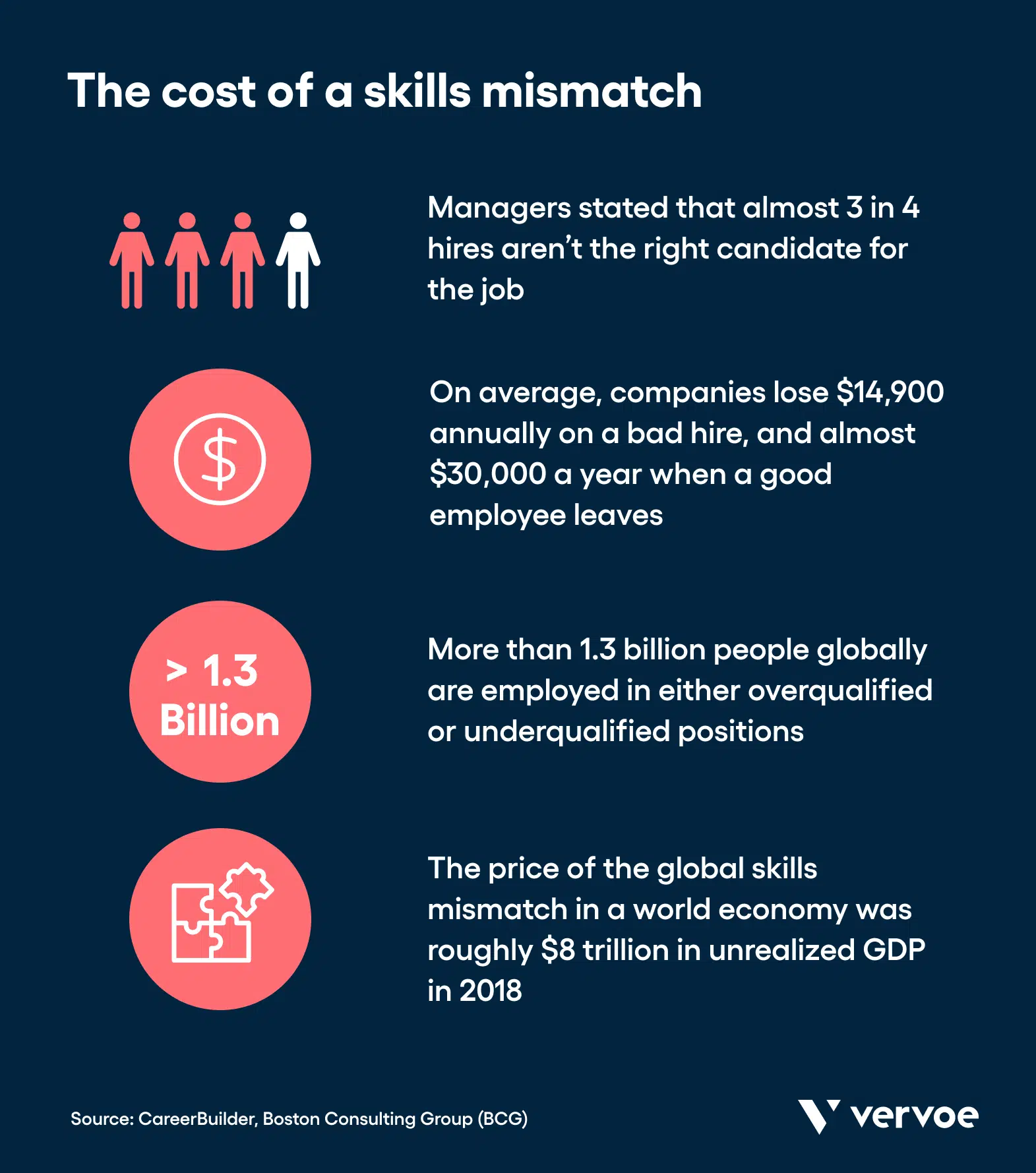
How to avoid a skills mismatch in your organization?
Given its complex nature and varying types, there’s no ‘one size fits all’ approach to solving the skills mismatch problem. However, there are simple tips all organizations can implement throughout the pre-hiring, hiring, and post-hiring process to help drastically reduce the chances of this occurring and feeling the full weight of yet another hire gone wrong.
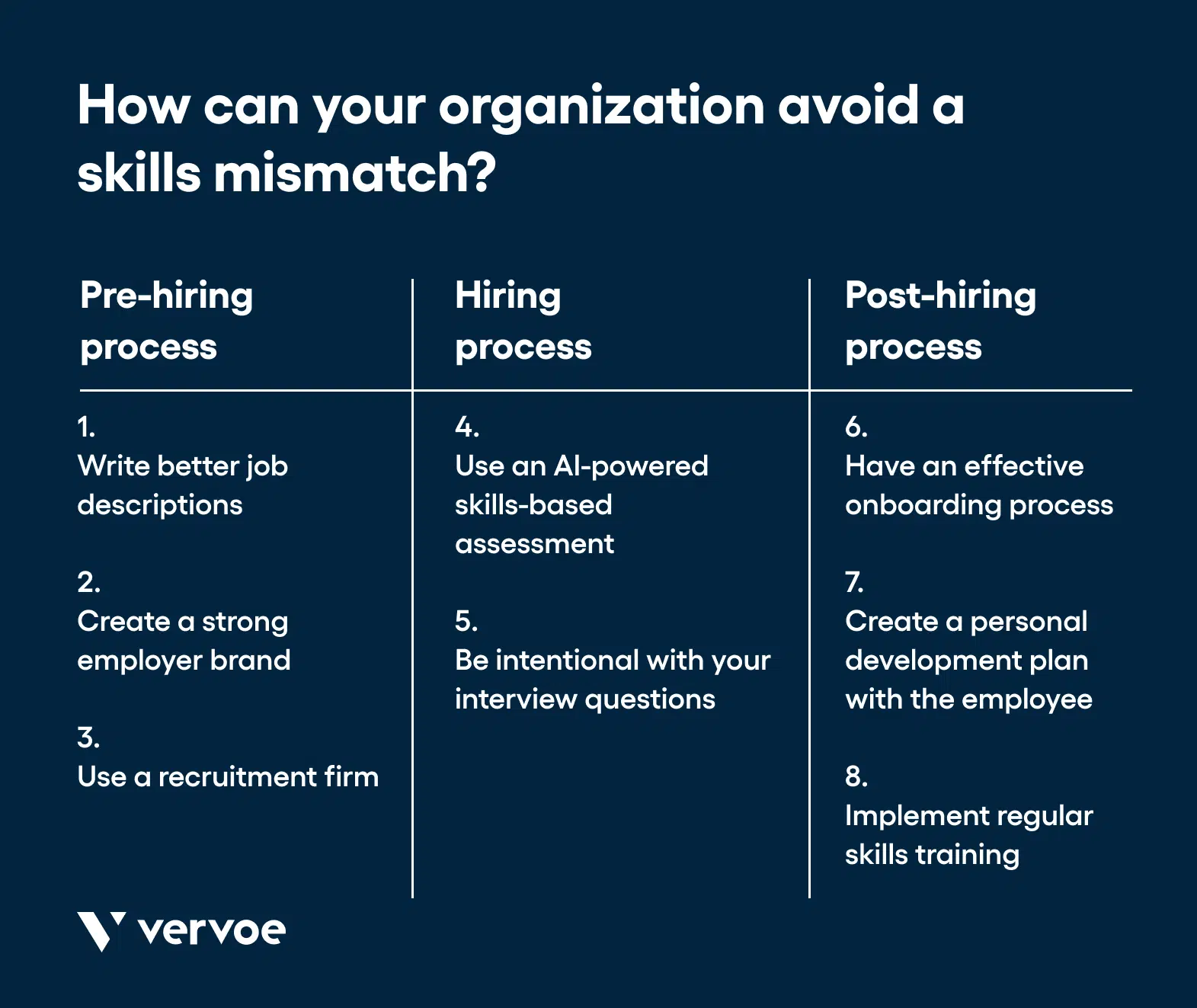
Pre-hiring process
The pre-hiring process is where most of the magic happens. And by magic, we mean the hard work that goes into preparing the job details, crafting the job description, mapping out what an ideal candidate looks like, and bringing it to fruition in your job postings. Here are some things to consider at this stage of the hiring journey to avoid any confusion about the requirements to succeed in the role, thus helping to minimize the risk of a skills mismatch:
1. Write skills-based job descriptions
When writing a job description, specificity is always key. Be clear and thorough about the skills you’re searching for and the requirements a candidate will need to meet to flourish in the role. After all, this is your first opportunity to minimize the risk of a skills mismatch.
It’s all well and good to inject some color into your job description to accurately reflect your brand and sell the benefits of working at your company. But don’t let that distract from the information that matters. Keep the important details — the skills — plain, straightforward, and presented on a mandatory to preferred scale, so there’s little room for misinterpretation. Call a spade a spade and leave little room for misinterpretation.
Your job description should include the following:
- An accurate job title that clearly describes the position (don’t bother being creative here, it’s more confusing than anything)
- An ideal candidate profile that lists their responsibilities, requirements, and what ‘a day in the life’ in this role will look like
- List the hard skills required to perform the job
- List the soft skills that are important to succeed in the role
- For best practice, only include the “must-have” skills in the job description. Often the “nice-to-have” skills, which can be taught on the job, act as a deterrent.
Lastly, think deeply about the requirements that are actually important to the role’s success, rather than leaning on commonly used recruitment phrases. If skills obsolescence teaches us anything, it’s that a candidate’s years of experience aren’t always the best indicator of their ability to perform the role well or at the standard required. For example, writing “3-5 years of experience needed” is less effective than writing “requiring a person who has experience operating X program.” Better job descriptions will result in better candidates and less chance of a skills mismatch.
2. Create a strong employer brand
An employer brand is the branding and marketing of the employment experience at an organization. Strong employer brands communicate a company’s identity and reputation in a way that creates a strong narrative that potential job candidates can buy into. This branding should make it easy to understand a company’s mission, culture, and reputation.
When you have a strong employer brand, and job seekers perceive your company as a desirable place to work, it helps to:
- Reduce the work required to market job vacancies: Candidates who admire an organization and want to be part of the culture are more likely to apply for a position within the company, increasing job applications.
- Bigger talent pool: With more applicants, there is a broader selection of people to choose from to ensure you select the most qualified candidates with the right skills rather than settling for an available option. In turn, this reduces the likelihood of a skills mismatch.
3. Use a recruitment firm
If you don’t have a solid and recognizable employer brand, you might want to look into partnering with a recruitment firm.
The benefits of calling on the expertise of a recruitment firm are that they’re aware of market trends and behavior and can act accordingly to help you attract more qualified candidates. Recruiters have the tools, network, and skills required to help source a suitable talent pool to minimize the risk of a skill mismatch.
If quality-of-hire and time-to-hire are at the top of your priority list, a recruitment firm is an effective way to boost your lead generation process to ensure you’re sourcing only the candidates with skill sets that match the requirements of the role.
Hiring process
During this part of the process, your primary goal is to adequately analyze, verify, and assess your candidates’ skills. While the pre-hiring phase sets you up for success (or failure), the recruitment process requires the most attention to detail to avoid a skill mismatch. Consider the following tips when approaching the hiring phase…
4. Use an AI-powered skills-based assessment
The unfortunate reality is that most people lie during the hiring process. According to a report by the reference checking company, Checkster, 78% of applicants misrepresent themselves on their resumes.
An effective way to verify your candidates’ claims is to test them on those precise skills they’ll need to master in your open role.
Vervoe’s AI-powered platform allows you to create an assessment customized to your organization’s unique requirements and the job you’re hiring for. This is then AI-graded to remove any bias from the process and rank candidates based on their ability to perform the duties most important to you, ensuring you’re finding the best candidate for the role every time.
The benefits of Vervoe’s AI skills-based assessments include:
- Verifying a candidate’s skills: It allows you to assess their skill set confidently and, thus, their suitability for the role. It adds proof to a candidate’s claims and gives you added reassurance that the chosen candidate is the right person for the job. Testing if someone can perform the duties required is the most effective way to reduce a skill mismatch.
- Removing bias from the recruitment process: the candidate has the opportunity to prove their competency. The results dictate if they’re successful or not, rather than unconscious biases or factors that do not influence their ability to perform in the role.
- Scaling to suit high-volume hiring: whether you get 50 applicants or 500, an AI-powered pre-employment test is a scalable solution that allows you to accurately pre-screen all candidates to ensure you’re not missing any remarkable talent.
- Saving time and resources: Finding the time and resources to pre-screen a high volume of applications can be tricky. Thanks to Vervoe’s intuitive automation, the platform’s AI-powered pre-screening will eliminate the tedious process and handle the hard work for you.
5. Be intentional with your interview questions
When assessing a candidate’s suitability for a role, the interview process is where you can clearly understand how a candidate will fit in culturally and ask any follow-up situational and soft skill questions.
If at this point of the process, you’ve already taken candidates through a skills-based assessment and have created a shortlist of top performers, you won’t need to focus on assessing their skills as much. This leaves more room to get a feel for their personality, ideal career progression, and additional behavioral and situational questions that allow you to assess their communication, presentation, and time-sensitive problem-solving, if applicable to the role they’re hiring for.
Post-hiring process
Once you’ve found the right candidate for the job, it’s time to integrate them into your company with the proper onboarding process that sets them up for success and ensures ongoing support and training to ensure their skills are up-to-date. According to a Careerbuilder survey, 1 in 10 employees has quit a workplace due to a poor onboarding experience.
6. Have an effective onboarding process
An employee’s first interaction with an organization matters, so it’s essential to have a well-thought-through onboarding plan. When onboarding, it’s important that the candidate integrates into your company in the following ways:
- Socially: It’s essential that the new skilled workers integrate socially with team members and colleagues in the company. If they don’t feel part of the company socially, they can disconnect and disengage from work.
- Operationally:The new hires need to be taught how their role functions and the team operates in their unique work environment. This isn’t just about the technical skills — it’s about how things are done in that specific company. A software engineer will already know how to code, but they need to learn about the report structure, internal processes, specific tools that the company uses, and how the team interacts.
7. Create a personal development plan with the employee
Generally, people are motivated by self-development, which includes professional development too. If an employee’s career progression and goals align with the organization, it improves overall satisfaction and willingness to continue fine-tuning their skills.
An effective way to keep an employee’s skills sharp is to have their manager work on a career development plan with them to combine personal and professional goals into an actionable plan. In doing so, you’re ensuring that your employee will grow along with the company and that their skills won’t become obsolete in a couple of years.
When working on an employee development plan, consider the following questions:
- What are the employee’s personal and career development goals? This can incorporate both soft and hard skills.
- What are the organizational needs and role development requirements? Consider how the employee’s goals might align with the organization’s needs and assess what the future of the role looks like to ensure the skill sets will align.
- How can these goals be turned into an action plan? Consider what formal training is required, and agree on a timeframe that suits both parties.
8. Implement regular skills training
If you received a medical degree fifty years ago and haven’t worked or updated your knowledge in the last twenty years, you wouldn’t be able to practice medicine today. Knowledge and technologies evolve over time, and with it, new processes and techniques come into play.
As such, the only way for employees to stay up-to-date with the latest innovations in their field is to undergo skills training regularly. Not only will this ensure your employees’ skills remain relevant, but it will also improve satisfaction in the workplace as they will feel more valued due to the investment in their development.
Conclusion
A skills mismatch can have a detrimental impact on the success of an organization. The effects of poor productivity, lower employee satisfaction, a more significant turnover rate, and financial loss are varied and costly, leaving a severe skills gap for organizations to fill.
Organizations can incorporate intentional steps during all stages of the hiring process — from job descriptions to employee onboarding and skills training — to ensure they’re choosing a candidate that aligns with their business requirements to help minimize the risk of a skills mismatch.
Above all else, one of the most time and cost-effective solutions to avoid a skills mismatch is implementing a pre-employment assessment in the hiring process, such as Vervoe. Book a demo call with our team today to reap the rewards of faster candidate screening, increased hiring diversity, more accurate candidate selection, and improved candidate experience.




















